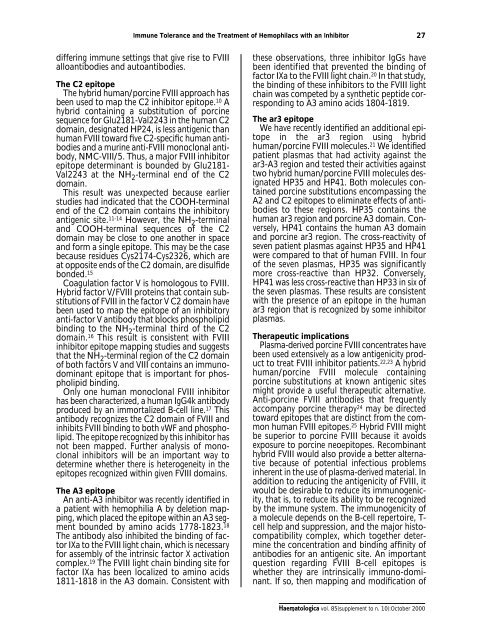Haematologica 2000;85:supplement to no. 10 - Supplements ...
Haematologica 2000;85:supplement to no. 10 - Supplements ...
Haematologica 2000;85:supplement to no. 10 - Supplements ...
You also want an ePaper? Increase the reach of your titles
YUMPU automatically turns print PDFs into web optimized ePapers that Google loves.
Immune Tolerance and the Treatment of Hemophilacs with an Inhibi<strong>to</strong>r 27<br />
differing immune settings that give rise <strong>to</strong> FVIII<br />
alloantibodies and au<strong>to</strong>antibodies.<br />
The C2 epi<strong>to</strong>pe<br />
The hybrid human/porcine FVIII approach has<br />
been used <strong>to</strong> map the C2 inhibi<strong>to</strong>r epi<strong>to</strong>pe. <strong>10</strong> A<br />
hybrid containing a substitution of porcine<br />
sequence for Glu2181-Val2243 in the human C2<br />
domain, designated HP24, is less antigenic than<br />
human FVIII <strong>to</strong>ward five C2-specific human antibodies<br />
and a murine anti-FVIII mo<strong>no</strong>clonal antibody,<br />
NMC-VIII/5. Thus, a major FVIII inhibi<strong>to</strong>r<br />
epi<strong>to</strong>pe determinant is bounded by Glu2181-<br />
Val2243 at the NH 2 -terminal end of the C2<br />
domain.<br />
This result was unexpected because earlier<br />
studies had indicated that the COOH-terminal<br />
end of the C2 domain contains the inhibi<strong>to</strong>ry<br />
antigenic site. 11-14 However, the NH 2 -terminal<br />
and COOH-terminal sequences of the C2<br />
domain may be close <strong>to</strong> one a<strong>no</strong>ther in space<br />
and form a single epi<strong>to</strong>pe. This may be the case<br />
because residues Cys2174-Cys2326, which are<br />
at opposite ends of the C2 domain, are disulfide<br />
bonded. 15<br />
Coagulation fac<strong>to</strong>r V is homologous <strong>to</strong> FVIII.<br />
Hybrid fac<strong>to</strong>r V/FVIII proteins that contain substitutions<br />
of FVIII in the fac<strong>to</strong>r V C2 domain have<br />
been used <strong>to</strong> map the epi<strong>to</strong>pe of an inhibi<strong>to</strong>ry<br />
anti-fac<strong>to</strong>r V antibody that blocks phospholipid<br />
binding <strong>to</strong> the NH 2 -terminal third of the C2<br />
domain. 16 This result is consistent with FVIII<br />
inhibi<strong>to</strong>r epi<strong>to</strong>pe mapping studies and suggests<br />
that the NH 2 -terminal region of the C2 domain<br />
of both fac<strong>to</strong>rs V and VIII contains an immu<strong>no</strong>dominant<br />
epi<strong>to</strong>pe that is important for phospholipid<br />
binding.<br />
Only one human mo<strong>no</strong>clonal FVIII inhibi<strong>to</strong>r<br />
has been characterized, a human IgG4k antibody<br />
produced by an immortalized B-cell line. 17 This<br />
antibody recognizes the C2 domain of FVIII and<br />
inhibits FVIII binding <strong>to</strong> both vWF and phospholipid.<br />
The epi<strong>to</strong>pe recognized by this inhibi<strong>to</strong>r has<br />
<strong>no</strong>t been mapped. Further analysis of mo<strong>no</strong>clonal<br />
inhibi<strong>to</strong>rs will be an important way <strong>to</strong><br />
determine whether there is heterogeneity in the<br />
epi<strong>to</strong>pes recognized within given FVIII domains.<br />
The A3 epi<strong>to</strong>pe<br />
An anti-A3 inhibi<strong>to</strong>r was recently identified in<br />
a patient with hemophilia A by deletion mapping,<br />
which placed the epi<strong>to</strong>pe within an A3 segment<br />
bounded by ami<strong>no</strong> acids 1778-1823. 18<br />
The antibody also inhibited the binding of fac<strong>to</strong>r<br />
IXa <strong>to</strong> the FVIII light chain, which is necessary<br />
for assembly of the intrinsic fac<strong>to</strong>r X activation<br />
complex. 19 The FVIII light chain binding site for<br />
fac<strong>to</strong>r IXa has been localized <strong>to</strong> ami<strong>no</strong> acids<br />
1811-1818 in the A3 domain. Consistent with<br />
these observations, three inhibi<strong>to</strong>r IgGs have<br />
been identified that prevented the binding of<br />
fac<strong>to</strong>r IXa <strong>to</strong> the FVIII light chain. 20 In that study,<br />
the binding of these inhibi<strong>to</strong>rs <strong>to</strong> the FVIII light<br />
chain was competed by a synthetic peptide corresponding<br />
<strong>to</strong> A3 ami<strong>no</strong> acids 1804-1819.<br />
The ar3 epi<strong>to</strong>pe<br />
We have recently identified an additional epi<strong>to</strong>pe<br />
in the ar3 region using hybrid<br />
human/porcine FVIII molecules. 21 We identified<br />
patient plasmas that had activity against the<br />
ar3-A3 region and tested their activities against<br />
two hybrid human/porcine FVIII molecules designated<br />
HP35 and HP41. Both molecules contained<br />
porcine substitutions encompassing the<br />
A2 and C2 epi<strong>to</strong>pes <strong>to</strong> eliminate effects of antibodies<br />
<strong>to</strong> these regions. HP35 contains the<br />
human ar3 region and porcine A3 domain. Conversely,<br />
HP41 contains the human A3 domain<br />
and porcine ar3 region. The cross-reactivity of<br />
seven patient plasmas against HP35 and HP41<br />
were compared <strong>to</strong> that of human FVIII. In four<br />
of the seven plasmas, HP35 was significantly<br />
more cross-reactive than HP32. Conversely,<br />
HP41 was less cross-reactive than HP33 in six of<br />
the seven plasmas. These results are consistent<br />
with the presence of an epi<strong>to</strong>pe in the human<br />
ar3 region that is recognized by some inhibi<strong>to</strong>r<br />
plasmas.<br />
Therapeutic implications<br />
Plasma-derived porcine FVIII concentrates have<br />
been used extensively as a low antigenicity product<br />
<strong>to</strong> treat FVIII inhibi<strong>to</strong>r patients. 22,23 A hybrid<br />
human/porcine FVIII molecule containing<br />
porcine substitutions at k<strong>no</strong>wn antigenic sites<br />
might provide a useful therapeutic alternative.<br />
Anti-porcine FVIII antibodies that frequently<br />
accompany porcine therapy 24 may be directed<br />
<strong>to</strong>ward epi<strong>to</strong>pes that are distinct from the common<br />
human FVIII epi<strong>to</strong>pes. 25 Hybrid FVIII might<br />
be superior <strong>to</strong> porcine FVIII because it avoids<br />
exposure <strong>to</strong> porcine neoepi<strong>to</strong>pes. Recombinant<br />
hybrid FVIII would also provide a better alternative<br />
because of potential infectious problems<br />
inherent in the use of plasma-derived material. In<br />
addition <strong>to</strong> reducing the antigenicity of FVIII, it<br />
would be desirable <strong>to</strong> reduce its immu<strong>no</strong>genicity,<br />
that is, <strong>to</strong> reduce its ability <strong>to</strong> be recognized<br />
by the immune system. The immu<strong>no</strong>genicity of<br />
a molecule depends on the B-cell reper<strong>to</strong>ire, T-<br />
cell help and suppression, and the major his<strong>to</strong>compatibility<br />
complex, which <strong>to</strong>gether determine<br />
the concentration and binding affinity of<br />
antibodies for an antigenic site. An important<br />
question regarding FVIII B-cell epi<strong>to</strong>pes is<br />
whether they are intrinsically immu<strong>no</strong>-dominant.<br />
If so, then mapping and modification of<br />
<strong>Haema<strong>to</strong>logica</strong> vol. <strong>85</strong>(<strong>supplement</strong> <strong>to</strong> n. <strong>10</strong>):Oc<strong>to</strong>ber <strong>2000</strong>
















